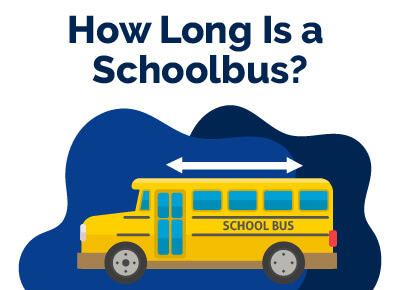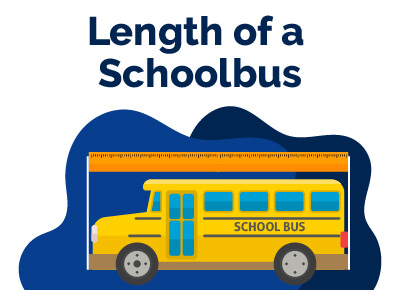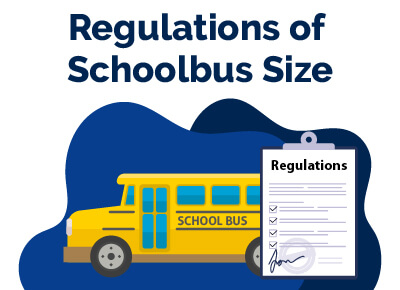How Long Is a Schoolbus? [For Different Types + Regulations]
February 6, 2024


Michael Collado is a car buying expert and has been a professional automotive writer since 2009. He’s written about dealership sales, vehicle reviews and comparisons, and service and maintenance for over 100 national automotive dealerships. Previously, Collado was a copywriter at the ad agency TBWA/Chiat/Day where he worked on brand campaigns for Nissan, ABC Television, Sony PlayStation, and Energizer. His recognition in the ad industry includes awards from Communication Arts and The Clios.
Collado has a Bachelor’s degree from the University of South Florida, with a major in Psychology and a minor in Marketing.
We know the wheels on the bus go ‘round and ‘round, but most of us don’t know exactly how long that bus is.
Typically, a magic school bus measures around 35 to 40 feet in length, ready to embark on countless educational journeys.
Let's take a look at the length of school buses, measurements for different types, regulations that dictate their dimensions, and the impact longer or shorter lengths have on safety and efficiency.
Table of Contents
Quick Guide for Types of School Buses
| Type A (Mini) | |||
| Type B | |||
| Type C | |||
| Type D |
Type A (Mini) School Buses
Type A (Mini) School Buses are ideally suited for routes with narrow roads and limited access, often utilized for special education or small group transportation. They are highly maneuverable and offer better fuel efficiency, making them cost-effective for short routes. These buses are equipped with essential safety features and are easier to evacuate due to their smaller size.
Type B School Buses
Type B School Buses serve best in suburban and rural areas, catering to medium-sized student populations. They provide a balance between maneuverability and fuel efficiency, suitable for regular routes. With a design enhancing driver visibility and student safety, these buses are equipped with multiple emergency exits and other safety features.
Type C School Buses
Type C School Buses are commonly used for regular transportation of larger student groups and longer routes. Their rear-engine layout ensures a quieter, cooler passenger compartment, enhancing comfort and safety. While less maneuverable in tight spaces, they offer moderate fuel efficiency optimized for consistent, longer routes.
Type D School Buses
Type D School Buses are the perfect choice for long-distance travel, such as field trips and sports events, accommodating the largest student capacities. Their robust build provides enhanced safety for long journeys. Although these buses are less maneuverable and not as fuel-efficient for short trips, they are designed for efficiency over long distances.
Length of a School Bus
 The average length of a school bus is around 40 feet. However, this can vary significantly depending on the model and type of school bus being used.
The average length of a school bus is around 40 feet. However, this can vary significantly depending on the model and type of school bus being used.
For example, some larger models may be up to 60 feet in length, while smaller buses designed for shorter routes or special needs students may be as short as 20 feet.
Variations in the length of school buses are often based on the specific purpose they will serve. Some districts use different sizes of buses for regular routes compared to long-distance trips or field trips that require greater seating capacity or additional storage space for luggage and equipment.
In addition, students with certain mobility disabilities may require shorter buses with lowered floors and wider entrances to accommodate wheelchairs or other mobility devices.
Regulations Regarding the Size and Dimensions of School Buses
 The NHTSA establishes regulations on the measurements of school buses, including a mandated minimum length of 21 feet and other specifics such as an overall width of 96 inches and a maximum height limit of 11 feet.
The NHTSA establishes regulations on the measurements of school buses, including a mandated minimum length of 21 feet and other specifics such as an overall width of 96 inches and a maximum height limit of 11 feet.
NHTSA also mandates that all new school buses come with necessary warning lights, stop arms, rearview mirrors, emergency exits, and other safety components.
Regulations on the size and shape of school buses differ from one state to another. Some states have adopted NHTSA's standards, while others may impose additional requirements or restrictions.
Some states mandate certain vehicles to abide by particular weight limits to be classified as a "school bus,” and others go a step further by also specifying minimum lengths for different types of vehicles or imposing stricter rules regarding mirrors or warning lights.
Local regulations on the size and dimensions of school buses can differ even more drastically than those at the state level and often have ordinances that have to be followed when it comes to vehicle sizes within their jurisdiction.
Alternative School Bus Uses
School buses aren’t just for students anymore. Folks transform these reliable behemoths for everything from mobile workshops to schoolies (RV conversions). Check out just a few possibilities below.
- Mobile Libraries: Transforming buses into traveling libraries that bring books to communities without easy access to a library.
- Community Transportation: Utilizing retired school buses for community shuttle services, especially in rural or underserved areas.
- Mobile Classrooms or Workshops: Equipping buses with educational materials and tools to provide learning opportunities in remote locations.
- Emergency Shelters or Response Units: Converting buses into temporary shelters or mobile response units for disaster relief efforts.
- Food Trucks or Mobile Cafes: Refurbishing old buses into mobile eateries or coffee shops.
- Traveling Art Galleries or Studios: Using buses as moving art exhibits or creative spaces for artists.
- Health Clinics: Outfitting buses with medical equipment to offer mobile health services, especially in areas lacking medical facilities.
- Hostels or Lodging: Turning buses into unique, budget-friendly accommodations for travelers.
- Event Transportation: Repurposing buses for transporting attendees at events like weddings, festivals, or tours.
- Recreational Vehicles (RVs): Customizing buses into RVs for personal or commercial use in travel and tourism.
Conclusion
And there you have it, just like the wheels on the bus, we've come full circle in our school bus exploration. Whether it's a compact mini or a sprawling 40-footer, each bus is geared up for its own expedition.
But don't let the journey end here! Join our FTBCP newsletter for the latest insights and tips in the world of vehicles. Keep your knowledge engine running and stay a step ahead in your car-buying quest.
Best Car Deals by Category
Frequently Asked Questions
What is the length of a bus?
Generally, school buses range from 20-45 feet in length, with many falling around 35-40 feet. Standard city buses are between 30-45 feet in length, while larger coach or tour buses may be up to 60 feet long.
How long is a 84 passenger school bus?
A typical 84-passenger school bus measures approximately 40 feet in length.
How long is a 48 passenger school bus?
The average length of a 48 passenger school bus is approximately 30 feet.
How long is a 78 passenger school bus?
A typical 78 passenger school bus is approximately 40 feet in length.
Posted in Uncategorized |




